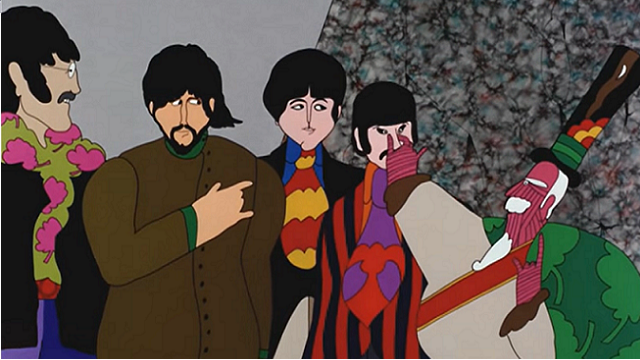There are five official Beatles films. A Hard Days’ Night captured how it must have felt to spend time with the Beatles circa 1964, listening to them quip as they travel from one show to another; Help! captured the experience of getting utterly blazed with them circa 1965 (Harrison would later remark he didn’t remember filming at all); Let It Be would capture the dissolving relationships of their late career. But Yellow Submarine was special, because of all the films it’s the only one that captures, in film form, the experience of listening to a Beatles album.
(Magical Mystery Tour captured about 52 minutes of footage)
The film’s production was, and still is, very unusual for an animated film – while there was a director, George Dunning, the animation crew was made up of two hundred people, and there’s only the slightest attempt made to keep the film’s look consistent – the movie shifts from predicting Terry Gilliam’s particular flavour of limited animation, to more traditional animation, to rotoscoping, to full-on deranged weirdness completely disconnected from reality. The plot itself is your pretty basic Alice In Wonderland job, as the Fab Four are brought from London to save Pepperland from the Blue Meanies, with a lot of digressions, musical numbers, and wordplay along the way.
This production, whether by design or accident, uncannily mirrors the production style of the Beatles themselves. A Beatles album had three strong creative visions at the core, guided by the disciplined hand of George Martin, keeping everything if not literally connected together then at least all of one piece, and supported by a highly skilled and creative technical crew. Revolver, Sergeant Pepper’s Lonely Hearts Club Band, and Magical Mystery Tour each have a clear aesthetic vision as a whole that allows McCartney, Lennon, and Harrison to free-wheel within it.
As you’d expect from my setup, the film reflects this process; the album it resembles most strongly is obviously Sgt Pepper’s, with the psychedelic imagery resembling both the album cover, the surreal lyrics, and the fact that Sgt Pepper’s has the closest of any album to an explicit story, set up in the first song and reprised just before the end, though it also predicts the almost total creative fracturing (in ways good and bad) of The White Album later that year. It’s an inherently psychedelic way of making a movie, one that presents a world where anything can happen and will look amazing as it does so; the only thing holding it together is the Beatles’ detached, ironic commentary (Martin also appears in the form of providing original score).
And, of course, it furthered the Beatles’ #brand. Ruck Colchez once observed that the Beatles and The Simpsons shared a common element, in that both initially became wildly popular doing a novel spin on an ordinary genre – dom coms for The Simpsons and pop music for the Beatles – and then using both that genre basis and that popularity to sell wild experimentation to the masses; Yellow Submarine fits into that, selling trippy animation by slapping The Beatles on it.

